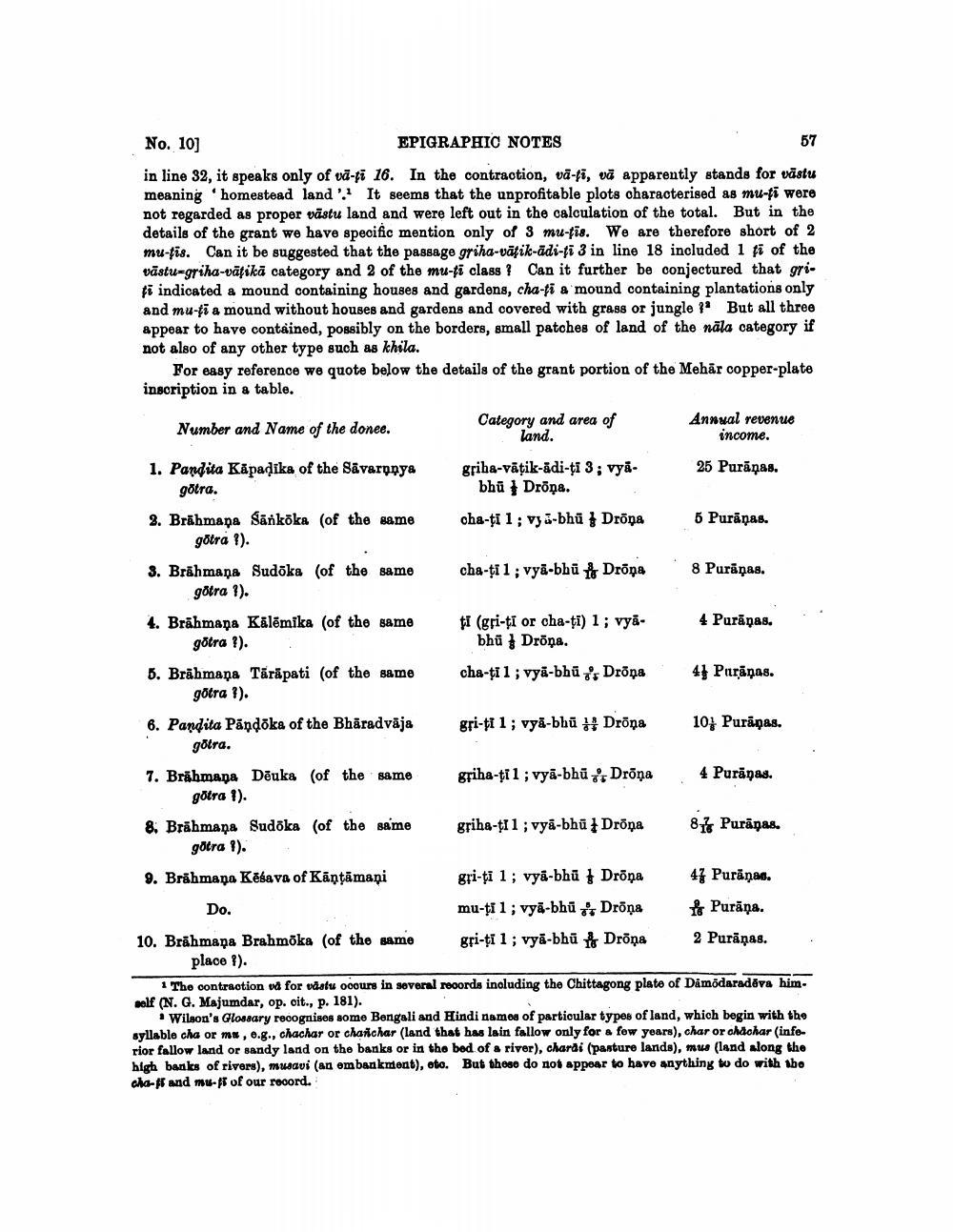________________
No. 10]
EPIGRAPHIC NOTES
57
in line 32, it speaks only of vă-ți 16. In the contraction, vā-ți, vā apparently stands for västu meaning homestead land. It seems that the unprofitable plots characterised as mu-ți were not regarded as proper västu land and were left out in the calculation of the total. But in the details of the grant we have specific mention only of 3 mu-fis. We are therefore short of 2 mu-fis. Can it be suggested that the passage griha-vätik-adi-ti 3 in line 18 included 1 fi of the vāstu-griha-vātikā category and 2 of the mu-ți class? Can it further be conjectured that grițī indicated a mound containing houses and gardens, cha-ti a mound containing plantations only and mu-ți a mound without houses and gardens and covered with grass or jungle ? But all three appear to have contained, possibly on the borders, small patches of land of the nala category if not also of any other type such as khila.
For easy reference we quote below the details of the grant portion of the Mehar copper-plate inscription in a table.
Number and Name of the donee.
1. Pandita Kapadika of the Savargnya götra.
2. Brahmaņa Sänkōka (of the same götra ?).
3. Brahmana Sudōka (of the same götra ?).
4. Brahmana Kalemika (of the same götra ?).
5. Brahmana Täräpati (of the same gōtra ?).
6. Pandita Pädöks of the Bharadvaja götra.
7. Brāhmaṇa Deuka (of the same gōtra 1).
8. Brahmana Sudōka (of the same götra 1).
9. Brahmana Kesava of Kanṭāmaņi
Do.
10. Brāhmaṇa Brahmōka (of the same place ?).
Category and area of land.
griha-vätik-adi-13; vybhū Drōņa.
cha-ti 1; vya-bhū Drōņa
chs-ţi 1; vya-bhi Droga
ti (gri-ti or cha-ti) 1; vyabhū Drōņa.
cha-ţi 1; vya-bhū Drōna
gri-ti 1; vya-bhū Drōna
griha-ţi 1; vya-bhū Drōņa
griha-111; vya-bhū ↓ Drôņa
gri-ţi 1; vya-bhū
mu-ţi 1; vya-bhū
gri-ți 1; vya-bhū
Drōna
Drōna
Drōna
Annual revenue income.
25 Purāņas.
5 Purāņas.
8 Purāņas.
4 Purāņas.
41 Paris.
10 Purānas.
4 Purānas.
8 Purāņas.
47 Purānas.
Purāņa.
2 Purāņas.
1 The contraction va for vastu occurs in several records including the Chittagong plate of Damodaradeva him. self (N. G. Majumdar, op. cit., p. 181).
Wilson's Glossary recognises some Bengali and Hindi names of particular types of land, which begin with the syllable cha or mu, e.g., chachar or chanchar (land that has lain fallow only for a few years), char or chachar (infe. rior fallow land or sandy land on the banks or in the bed of a river), charai (pasture lands), mus (land along the high banks of rivers), musavi (an embankment), etc. But these do not appear to have anything to do with the cha-fi and mu-fi of our record.




